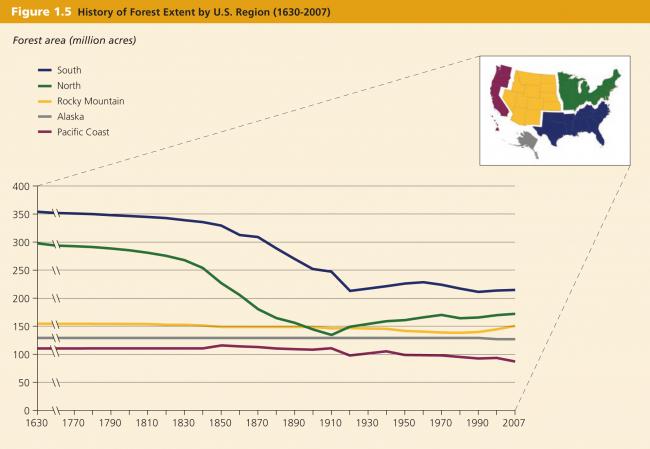Forests of Change
Southern forests are forests of continual change. Prior to European settlement, these forests were shaped by natural disturbances such as climatic warming after the last ice age, hurricanes, and natural fires, as well as by fires set by Native Americans. At the dawn of European settlement in the region in the early 1600s, southern forests covered an estimated 350 million acres or more. Over the next four centuries, greater than 99 percent of this acreage was cut at one time or another for agriculture, timber, or settlements.1 A testament to the renewability and resiliency of forests, much of the land regenerated over time as secondary forest. Nonetheless, approximately 40 percent of the pre-European settlement forest acreage has been converted to other uses. Only the northern forests—from Maine to Minnesota—have experienced a comparable decline in forest cover in the United States over this time period (Figure 1.5).
 Source: Forest data (USDA Forest Service 2000, Smith et al. 2009), administrative boundaries (ESRI Data and Maps 9.3.1, ESRI 2008).
Source: Forest data (USDA Forest Service 2000, Smith et al. 2009), administrative boundaries (ESRI Data and Maps 9.3.1, ESRI 2008).Several drivers of change continue to affect the quantity (extent and distribution) and quality (composition and health) of southern forests. “Direct drivers” are factors—of natural or human origin—that cause changes in an ecosystem and thereby increase or decrease its ability to provide certain ecosystem services. Some drivers increase forest quantity or quality while others decrease them. Prominent drivers include:
- Suburban encroachment. Suburban residential and commercial development is the driver of change most likely to decrease southern forest extent over the coming decades.
- Reversion of agricultural land. In some areas of the South, particularly in the western part of the region, forest extent is expanding as agricultural land reverts to forest.
- Climate change. Climate change may have a number of impacts, including shifting the distribution of some species, inundating low-lying coastal forests, increasing instances of saltwater intrusion, and stressing drought-intolerant species.
- Wildfire. The suppression of natural, low-intensity forest fires during much of the 20th century has led to a build-up of fuel, increasing the risk of high-intensity wildfires in some areas, and has altered the species composition of fire-adapted forests.
- Pests and pathogens. Outbreaks of native insects such as the southern pine beetle, non-native insects such as gypsy moths and the hemlock woolly adelgid, native pathogens such as oak wilt, and non-native pathogens such as dogwood anthracnose and butternut canker are affecting a variety of tree species and may affect southern forest species composition and health.
Going forward, these drivers of change will likely impact the ability of southern forests to continue to provide a full range of ecosystem services. How private landowners, businesses, conservation organizations, governments, and citizens respond and adapt to these and other drivers ultimately will shape southern forests for the future.
-
Trani, Margaret K. 2002b. “Terrestrial Ecosystems.” In Wear, David N., and John G. Greis, eds. Southern Forest Resource Assessment. Gen. Tech. Rep. SRS-53. Asheville, NC: U.S. Department of Agriculture, Forest Service, Southern Research Station. ↩



